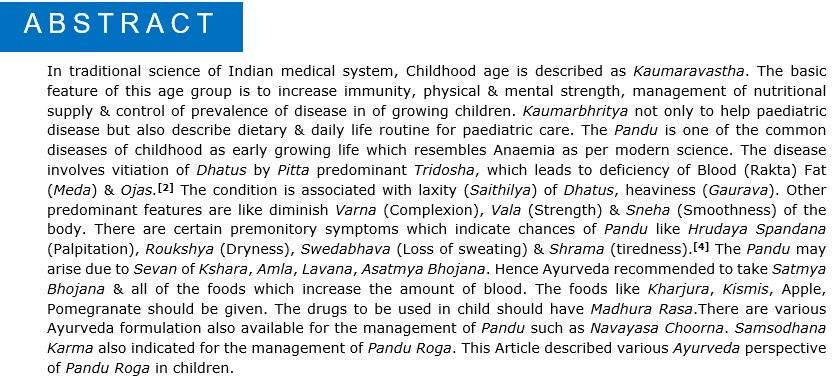A literary review on Ayurveda perspective of Pandu in Kaumarabhritya
DOI:
https://doi.org/10.21760/jaims.9.3.20Keywords:
Ayurveda, Pandu, Anaemia, Navayasa ChoornaAbstract
In traditional science of Indian medical system, Childhood age is described as Kaumaravastha. The basic feature of this age group is to increase immunity, physical & mental strength, management of nutritional supply & control of prevalence of disease in of growing children. Kaumarbhritya not only to help paediatric disease but also describe dietary & daily life routine for paediatric care. The Pandu is one of the common diseases of childhood as early growing life which resembles Anaemia as per modern science. The disease involves vitiation of Dhatus by Pitta predominant Tridosha, which leads to deficiency of Blood (Rakta) Fat (Meda) & Ojas.[2] The condition is associated with laxity (Saithilya) of Dhatus, heaviness (Gaurava). Other predominant features are like diminish Varna (Complexion), Vala (Strength) & Sneha (Smoothness) of the body. There are certain premonitory symptoms which indicate chances of Pandu like Hrudaya Spandana (Palpitation), Roukshya (Dryness), Swedabhava (Loss of sweating) & Shrama (tiredness).[4] The Pandu may arise due to Sevan of Kshara, Amla, Lavana, Asatmya Bhojana. Hence Ayurveda recommended to take Satmya Bhojana & all of the foods which increase the amount of blood. The foods like Kharjura, Kismis, Apple, Pomegranate should be given. The drugs to be used in child should have Madhura Rasa.There are various Ayurveda formulation also available for the management of Pandu such as Navayasa Choorna. Samsodhana Karma also indicated for the management of Pandu Roga. This Article described various Ayurveda perspective of Pandu Roga in children.
Downloads
References
Vriddha Jeevaka-Kashyapa Samhita preached by Maharshi Maricha Kashyapa, summarised by Vriddha Jeevaka redacted by Vatsya with Sanskrit Introduction by Nepal Rajguru Pandit Hemraj Sharma with Vidyotini Hindi commentary by Ayurvedalankar Sri Satyapal Bhisagacharya, Chaukhamba Sanskrit Samsthan Varanasi (India)
Agnivesha-charak samhita,volume 2 with charak chandrika Hindi commentary edited by Dr Brahmanand Tripathi published by Chaukhamba Sanskrit Prakashan,Varanasi-reprint 2004
Sushruta-Sushruta Samhita (Part 1 & Part 2) edited with Sushruta Vimarshini Hindi Commentary by Dr Anantram Sharma, published by Chaukhamba Surbharati Prakashan, Varanasi, 1st edition 2001
Ashtang Hridayam with the Vidyotini Hindi Commentary by Kaviraj Atridev Gupta, published by Chaukhamba Sankrit Samsthan, Varanasi 3rd edition 2005
Bhaishajyaratnavali vidyotini Hindivyakhya Vimarsha parishishtasahita by kaviraj shri Ambikadutt Shastri Ayurvedacharya, Chaukhamba Sansrit Samsthan, Varanasi-2001
Bhavaprakasha of shri Bhav Mishra including Nighantu portion edited with the Vidyotini Hindi Commentary-by Shri Brahmasankar Mishra 1st part, Chaukhamba Sanskrit Samsthan,Varanasi 2002.
Acharya Priyavrat Sharma-Dravyaguna Vigyan, Chaukhamba Bharati Academy,Varanasi Reprint year 2013.
Madhav Nidana (Part 1) with Madhukosha Sanskrit commentary of Vijaya Rakshit & Shrikantha Dutta, Vidyotini Hindi Commentary by Sudarshan Shastri, Chaukhamba Sanskrit Pratishthan ,1st edition 1993.















